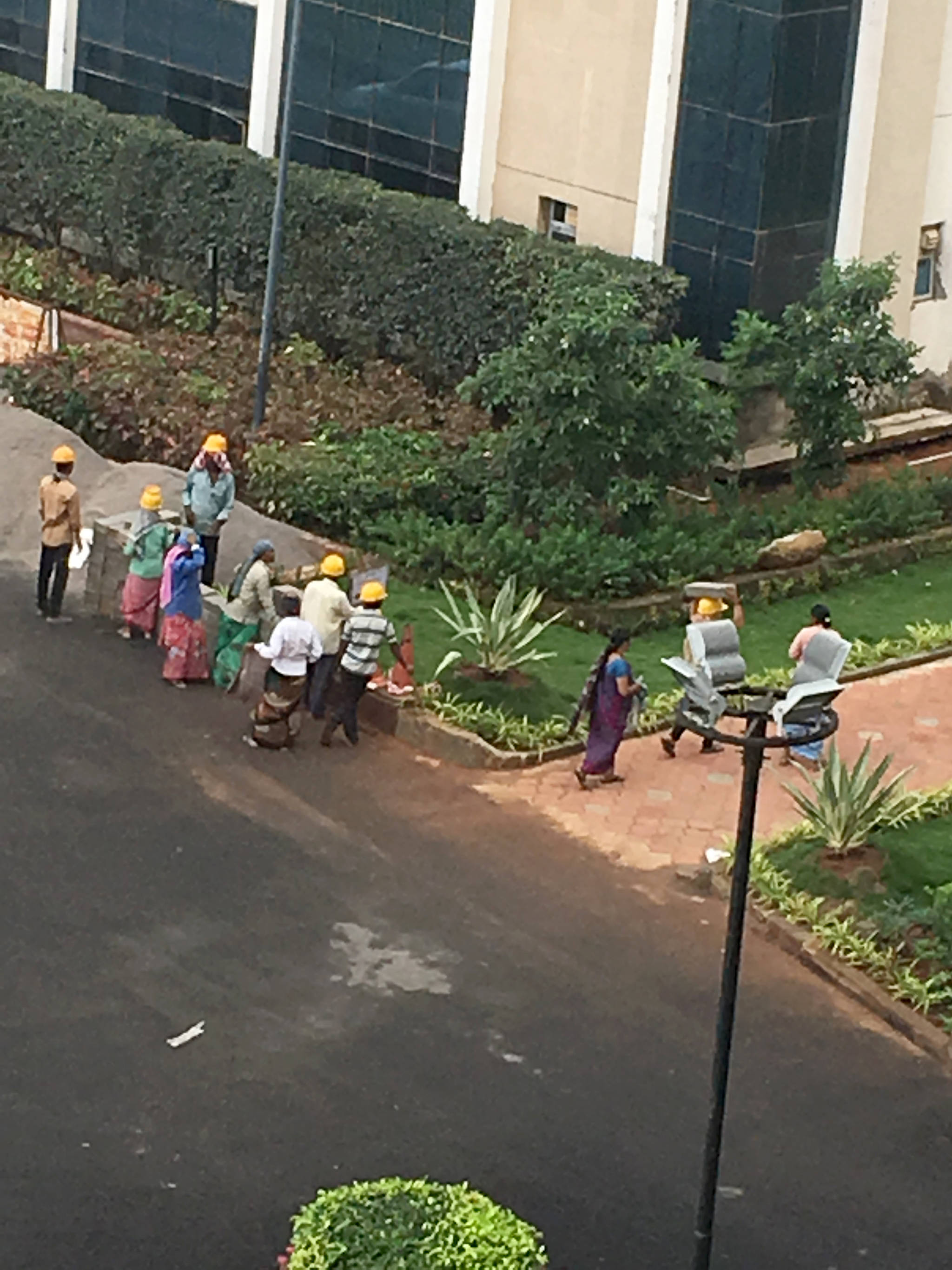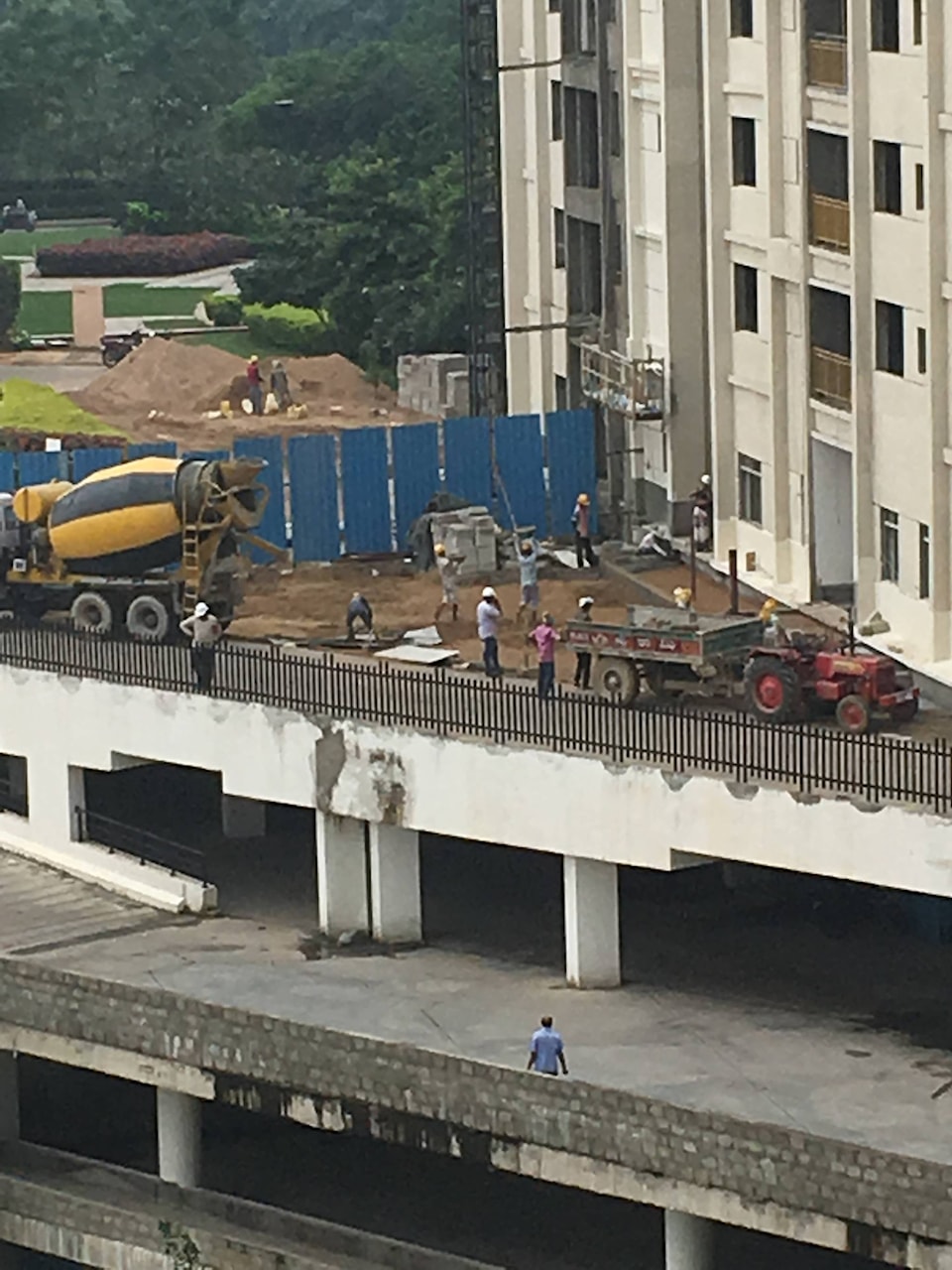Hyderabad’s emergence into a ‘first world’ city has been driven mainly by the technology industry.
The city is home to Microsoft ( their largest campus outside the U.S.), Google, Amazon.com, Oracle and Cisco, to name but a few of the major information and technology companies with offices here.
Hyderabad has emerged as a pharmaceutical and biotechnology hub as well, and is known as India’s pharmaceutical capital, with bio-pharmaceuticals exports reaching $3.1 billion USD in 2008-09. Deloitte, KPMG, Bank of America and GE Capital have established their operations in the city.
This business growth has spurred a surge in the construction industry for both new commercial sites as well as domestic buildings. With most of the inner-city land already utilized, there is only one way to go, and that is up. There are two new towers being built in our complex at Lanco Hills, and with my being incapacitated due to a leg injury I sustained, I have spent many hours watching the building construction and, more so, the workers performing their tasks.
All current building construction is a post-and-beam system, with the framework all from poured concrete. I was not here when this framework was completed, but I have to assume it was done with one of the concrete pumper trucks I have seen around town on big pours.
The next step is building in the exterior and interior walls. These are all constructed with cinder blocks and then made smooth through the parging process. The building across from my patio is a 32-storey tower with nine suites per floor.
Try, for a moment, to imagine the number of blocks that it would take to complete a project of that size. Now picture every single one of those blocks being moved by hand.
They are hand-loaded onto a freight truck and delivered to the sight, where workers unload each individual piece by hand and restack for later use. When they are needed, they are again moved by hand to the elevator and once on the correct floor, each block is individually moved into a neat stack for use by the mason. There are no pallets or forklifts used on these projects, just brute strength and endurance.
I would also point out that many of these workers are elderly women, who do not miss a beat when it comes to the physical aspect of the workload. They move brick for brick with their male counterparts and show no signs of inequality.
The parging cement is all mixed on the floor of the room it is being applied. That means moving every 25kg bag of cement, and the required sand to make the mixture, to the elevator and off the elevator to the appropriate room for mixing by hand on the floor.
I have witnessed many tandem dump trucks come in during the evening when construction is done for the day, and dump several loads of sand in specific staging areas. First thing the next morning, there are employees bagging the sand into empty bags and getting them ready to move upstairs.
Again, try to imagine the magnitude of this undertaking. Thousands and thousands of yards of sand, all hand bagged and carried to the desired work station. A few days ago I watched two workers prepare an area outside the main entrance for a retaining wall that will become part of the entry sidewalk. Using a shovel that has a three-foot handle and a large backwards blade much like a garden hoe, they dug down about three feet and three feet wide for a distance of 25 feet. This took a good portion of the day to complete, but was ready for the brick layer who built the barrier of cinder blocks first thing the next morning, and then finished it into a beautiful smooth wall.
As the exterior walls of the building are completed, they are painted with a sealer to protect them from the weather prior to final painting. This job is completed by two very brave souls who are suspended from the top of the building on a static rope – yes, rope, not cable – and they lower themselves down with a caribiner set up that gives them descent control. They have a five-gallon bucket attached to their waist and a roller and brush. No fall protection, safety line or safety net should a catastrophic failure occur to their tether. They do wear hard hats though, so that is some good use of PPE, as long as it stays on when they are in flight.
Yesterday I was treated to the pouring of a cement sidewalk. This was a six-yard pour and was delivered by a mixer truck – pretty standard. Where the difference started to show was the actual pour itself. The truck was equipped with only the first stage chute of about three feet. Sheets of corrugated metal that are used normally for construction site boundary walls were placed under the chute and deliveries were made at about a yard at a time onto this make shift platform.
Using the hoe-style shovel, one of three employees filled head bowls (just slightly larger than the largest pasta bowl you can imagine) and the concrete mixture was head carried to the placement site and dumped. Using a rotating three-bowl system with two runners, I was astounded at how quickly they were able to move all the cement and complete the pour. The workers also rotated jobs to give the carriers a break and keep the production moving at top speed.
Today I am watching the movement of blocks and sand for a new sidewalk being installed in an existing grass area. Again, blocks pile on heads and an assembly line of sorts to ensure no one gets too fatigued and – presto! – a large stack of patio blocks is moved and now they are on the two piles of sand to level the blocks.
I at first looked at these labour-intensive systems and thought, “Boy, could I speed things up with my skidsteer. No one should have to work that hard when there are machines to do the job.”
But these people are working. They are bringing in a much-needed income to a family that can not work in the above mentioned hi-tech or pharmaceutical industry.
This city has nearly eight million people and the government and the construction companies know that this is the best way to keep the economy rolling.
In Canada, we are often far to quick to jump at an opportunity to modernize and save our company money and several jobs that can be done with one machine, regardless of what that means to the families of the outgoing employees.
The work is hard, but the people are happy. Happy to have the ability to work, earn a living and be able to feed their family. Sure, some of it seems unsafe. Like working at a construction site with steel and concrete blocks, saws and grinders, all the while working barefoot or wearing flip-flops. Or hanging precariously from a 32-storey building without fall protection.
This is a way of life that has gone on for generations. An honest day’s work for a few honest rupees. What an ingenious notion.

